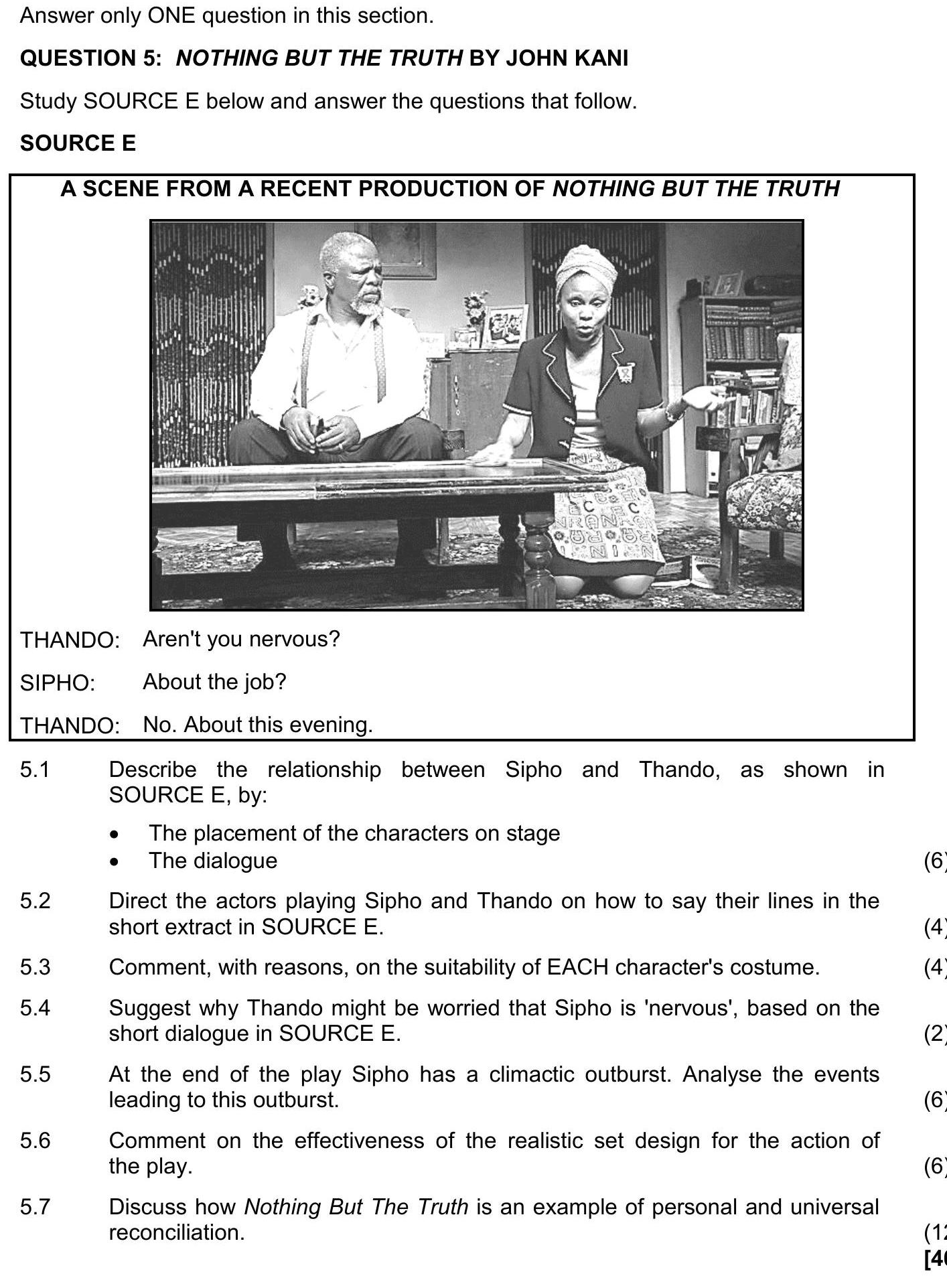Photo AI
QUESTION 5: NOTHING BUT THE TRUTH BY JOHN KANI SOURCE E A SCENE FROM A RECENT PRODUCTION OF NOTHING BUT THE TRUTH THANDO: Aren't you nervous? SIPHO: About the job? THANDO: No - NSC Dramatic Arts - Question 5 - 2018 - Paper 1
Question 5

QUESTION 5: NOTHING BUT THE TRUTH BY JOHN KANI SOURCE E A SCENE FROM A RECENT PRODUCTION OF NOTHING BUT THE TRUTH THANDO: Aren't you nervous? SIPHO: About the job... show full transcript
Worked Solution & Example Answer:QUESTION 5: NOTHING BUT THE TRUTH BY JOHN KANI SOURCE E A SCENE FROM A RECENT PRODUCTION OF NOTHING BUT THE TRUTH THANDO: Aren't you nervous? SIPHO: About the job? THANDO: No - NSC Dramatic Arts - Question 5 - 2018 - Paper 1
Step 1
Describe the relationship between Sipho and Thando, as shown in SOURCE E, by: • The placement of the characters on stage
Answer
The placement of Sipho and Thando on stage reflects their relationship as well as their emotional dynamics. Sipho is seated in a position of authority in a chair, which signifies his role as the more experienced figure, while Thando kneels on the floor. This positioning indicates a hierarchical nature in their relationship, with Thando possibly looking up to Sipho. Their physical closeness, however, as they are almost on the same level, suggests an intimate bond. Thando’s lower position may also suggest her place as someone caring and supportive, demonstrating her vulnerability in front of Sipho.
Step 2
The dialogue
Answer
The dialogue between Sipho and Thando reveals their relationship deeply. Thando's question, 'Aren't you nervous?' indicates her concern for Sipho, showcasing her caring nature. Sipho’s reply indicates a level of ease or confidence; however, his casual dismissal of Thando's concern about 'this evening' may hint at deeper issues he is grappling with. This exchange reflects both the warmth and tension present in their relationship, demonstrating that while they share a bond, there are unaddressed emotions and worries that impact their connection.
Step 3
Direct the actors playing Sipho and Thando on how to say their lines in the short extract in SOURCE E.
Answer
The actor portraying Sipho should deliver his lines with a calm and composed demeanor, reflecting his confidence. When saying, 'No. About this evening,' he should pause slightly for emphasis, suggesting that he is trying to downplay any underlying stress. On the other hand, Thando should express concern through her tone, using a questioning inflection on 'Aren't you nervous?' This line should be delivered with a slight rush, reflecting her anxiousness and care for Sipho, while also demonstrating a bit of her submissive role in the dynamic.
Step 4
Comment, with reasons, on the suitability of EACH character's costume.
Answer
Sipho's costume, consisting of a suit and tie, is suitable as it reflects his position as the assistant chief librarian. This attire suggests professionalism and authority, synonymous with his character's responsibilities. Conversely, Thando’s costume features an apron and a simple dress, indicative of her role in domestic work. This is appropriate as it aligns with her character's responsibilities, reflecting her traditional view in society. The contrast in their clothing signifies their differing social standings and roles within the family.
Step 5
Suggest why Thando might be worried that Sipho is 'nervous', based on the short dialogue in SOURCE E.
Answer
Thando might be worried that Sipho is 'nervous' due to several contextual clues from their dialogue. Firstly, this evening could signify a significant event or confrontation that may bring up past tensions. Additionally, the fact that Thando is directly asking about Sipho's nerves indicates her awareness of his emotional state, implying that prior experiences or discussions may have raised concerns about how he handles stress or pressure.
Step 6
At the end of the play Sipho has a climatic outburst. Analyze the events leading to this outburst.
Answer
The events leading to Sipho's climatic outburst include several emotional and relational tensions that build throughout the play. Notable factors are Mandisa's arrival with ashes, reflecting unresolved family issues, and conversations regarding their father, which heighten Sipho’s frustrations and feelings of being unsupported. His growing anger towards Mandisa’s disrespect, combined with his unfulfilled expectations as the chief librarian, serve as a catalyst for the outburst. The culmination of these personal and familial conflicts creates a pressure cooker environment leading to his eventual explosion.
Step 7
Comment on the effectiveness of the realistic set design for the action of the play.
Answer
The realistic set design significantly enhances the action of the play by creating an engaging and relatable environment for the audience. Elements like the bookshelves, furnishings, and the overall layout contribute to an authentic depiction of Sipho's home, grounding the characters' interactions in a relatable space. The seating arrangement allows for intimate conversations, while the presence of domestic items reinforces the play's themes of family and personal history. Consequently, this design choice effectively immerses the audience in the characters' realities, enhancing emotional engagement.
Step 8
Discuss how Nothing But The Truth is an example of personal and universal reconciliation.
Answer
Nothing But The Truth exemplifies personal and universal reconciliation through its examination of broken familial relationships and broader societal conflicts. The characters navigate their personal grievances, striving to reconcile their differences stemming from past conflicts—most notably, Sipho and Thando's relationship with their father. The play also reflects universal themes of reconciliation in a post-Apartheid South Africa, where individuals strive to mend broken ties, addressing the complexities of cultural identity and acceptance. Through its character arcs and actions, the play portrays the struggles and necessity of reconciling with both personal history and communal past.
